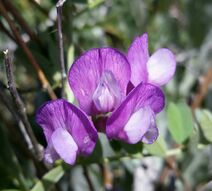Vicia americana
| Vicia americana | |
 | |
| Light: | |
| Moisture: | |
| Soil pH: | 5.6-8.4 |
| Self Pollinated | |
| Height: | 3' |
| Width: | 3' |
| Blooms: | Mid Summer |
| Native to: | |
| Nitrogen Fixer | |
| Edible Rating: | |
| Medicinal Rating: | |
| Tea: | Yes |
Vicia americana (common name: American vetch)
Propagation: Pre-soak the seed for 24 hours in warm water and then sow in situ in spring or autumn.
Cultivation: We have very little information on this species and do not know if it will be hardy in Britain, though judging by its native range it should succeed outdoors in many parts of the country. The following notes are based on the general needs of the genus.
Succeeds in any well-drained soil in a sunny position if the soil is reliably moist throughout the growing season, otherwise it is best grown in semi-shade[1].
A climbing plant, attaching itself to supports by means of tendrils[2].
This species has a symbiotic relationship with certain soil bacteria, these bacteria form nodules on the roots and fix atmospheric nitrogen. Some of this nitrogen is utilized by the growing plant but some can also be used by other plants growing nearby[1].
Range: N. America - Alaska to Ontario and New York, south to Virginia, Kentucky and Arizona.
Habitat: Damp or gravelly slopes, thickets and meadows[3].
Edibility: Young shoots - cooked[4][5][6].
The tender seeds are eaten by the N. American Indians[2]. Both the mature seeds and the immature seedpods can be used[7]. The pod is about 3cm long and contains 4 - 7 seeds[8].
Medicinal: The leaves have been rubbed in the hands and applied to spider bites[7]. An infusion of the crushed leaves have been used as a bath for treating soreness[7].
An infusion of the plant has been used as an eyewash[7].
An infusion of the leaves has been used by women as a love medicine[7].
Usage: The stout roots have been used for tying[7].
Pollinators: Insects
Notes: Any members of this genus could be considered, though there are occasional cases reported of toxicity. For example, the broad bean (V. faba) causes a disease called 'Favism' in some people. Favism only occurs in cases of excessive consumption of the seed
Soil: Can grow in light, medium, and heavy soils.
Drainage: Prefers well drained soil.
Flower Type: Hermaphrodite
Links
- Vicia americana - Plants for a Future
- Vicia americana - USDA Plant Profile
References
- ↑ 1.0 1.1 Huxley, Anthony. The New Royal Horticultural Society Dictionary of Gardening. MacMillan Press, 1992.
- ↑ 2.0 2.1 Davis, Ray and Frank Craighead. A Field Guide to Rocky Mountain Wildflowers. The Riverside Press, 1963.
- ↑ Lyndon, Merritt. Gray's Manual of Botany. American Book Co, 1950.
- ↑ Tanaka, Tyōzaburō. Tanaka's Cyclopaedia of Edible Plants of the World. Keigaku Publishing, 1976.
- ↑ Arnberger, Leslie. Flowers of the Southwest Mountains. Southwestern Monuments, 1968.
- ↑ Yanovsky, Elias. Food Plants of the North American Indians Publication 237. US Department of Agriculture.
- ↑ 7.0 7.1 7.2 7.3 7.4 7.5 Moerman, Daniel. Native American Ethnobotany. Timber Press, 1998.
- ↑ Britton, Nathaniel and Addison Brown. An Illustrated Flora of the Northern United States and Canada. Dover Publications, 1970.